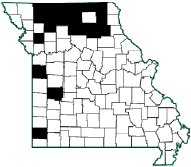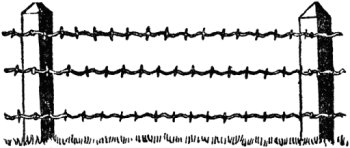AgEBB-MU CAFNR Extension
Green Horizons
Volume 25, Number 2
Spring 2021
Good Fences Make Good Neighbors Part 1: General Fence Law
Hank Stelzer, MU Extension
Time and Mother Nature (particularly over the past winter and spring) can wreak havoc on fence lines. If you are faced with repairing or replacing a boundary fence line, now is a good time to review Missouri's current fencing and boundary laws, particularly if you are new to the Show-Me State.
In Part I of this three-part series, we will look at fencing and boundary laws in "general fence law counties." Part II will look at the differences in "optional fence law" counties. Part III will deal specifically with liability for trespass by livestock and boundary line disputes.
More information can be found in MU Guide G810: Missouri Fencing and Boundary Laws and Guide 811: Missouri's Fencing and Boundary Laws: Frequently Asked Questions. Do not rely upon this series or G810 or G811 for legal advice. This information is a general statement of the law. Direct your questions to an attorney. Your attorney can get relevant facts and act on them in your best interest.
 |
| Figure 1: Counties that have adopted the Optional County Fencing Statute |
General vs. Local Option Fence Law Counties
Missouri's first fence law was enacted in 1808 while Missouri was still within the Louisiana Territory. Since that initial law there have been many changes to the "general" fence law of the state.
In 1963 the Missouri Legislature enacted major changes in the fence law by authorizing the "local option" fence law. Adoption of the local option for a county required a majority vote at a county election. The issue could be put on the local ballot either by motion of the county court or upon the petition of 100 real estate owners of 10 or more acres in the county. Currently, 19 of Missouri's 114 counties have adopted the Optional County Fencing Statute (Figure 1).
The latest major revision to the State's fence law came in 2016. That change pertains primarily to "general fence law counties," but also impacts the entire state.
Modified Forced Contribution and Maintenance
This is a major change. Only if your neighbor has livestock placed against the division fence can he/she be forced to pay for half the cost of construction, as well as be required to maintain the right-hand half. If the neighbor doesn't have livestock against the fence, you will have to put up the entire cost of the division fence and maintain the entire fence.
A landowner building the entire division fence must report the total cost to the associate circuit judge, who will authorize the cost to be recorded on each neighbor's deed. If your neighbor later places livestock against the division fence, then you can get reimbursed for one-half the construction costs. Unfortunately, this has not worked well since the law change in 2001.
Two areas continue to be confusing under the updated general law. First, landowners who do not want to contribute will try several things to avoid the law. (1) Not putting livestock in the bordering field. This works if livestock are never in that field (crop, hay, timber). (2) Putting wires and posts 10 feet or some part off the property line to not pay for part. That may work but if it stays there 10 years, you could lose the 10 feet by adverse possession. Second, livestock definition can be misinterpreted. If one show calf or horse stays in the field enclosure or cattle are allowed in to temporarily graze cornstalks, you are a livestock owner for the purpose of the law.
The Right-hand Rule
Most of us assumed there was a "right-hand rule" as a custom, but there was no such language in the former statute. Now the statute clearly says neighbors who cannot agree on who is to build and maintain which portion of a fence shall apply the right-hand rule. Each neighbor stands on his or her land looking at the common boundary, finds the midpoint, and is responsible for the half to his/her right.
This assumes each neighbor has livestock against the division fence. Where your neighbor doesn't have livestock against the fence, then you will have to build and maintain the whole fence until such time as your neighbor places livestock against it. And you can enter upon your neighbor's land to build and to maintain your share of the division fence. The non-livestock owning individual has no say in said fence either!
Under the prior law, you would have to take your neighbor to court if you and your neighbor couldn't reach an agreement as to which fence portion was whose responsibility to build and to maintain. While this remains true, many courts do not do this as common practice today.
What is a "Lawful Fence"?
Some may think the new statutory definition of "lawful fence" is still too cumbersome and confusing, but you should have seen it under the prior law! Basically, as the law now reads, a "lawful fence" is any fence consisting of posts and wire or boards at least 4 feet high (and mutually agreed upon by adjoining landowners or decided upon by the associate circuit court), with posts set firmly in the ground not more than 12 feet apart. No number of boards or wire is set in law but the fence must maintain livestock.
A question occurs when both neighbors have livestock against the division fence but one neighbor wants a more costly fence, probably because his livestock require a stronger or higher fence. The associate circuit court for your county will be the ultimate decider on that issue. The new statute states that you can build the neighbor's portion in excess of the lawful fence required (but presumably at your own expense). The neighbor (assuming they own livestock) can only be responsible to cover the cost of the legal half.
Actual vs. Double Damages?
Under the new statute, if your neighbor's right-hand division fence is in need of repair and his/her animals trespass onto your land, then your neighbor is liable for the actual damages done to your crops or livestock, but no longer for double damages. What is interesting to note here is the term, "crops." Are your trees considered a crop? They might not be if you do not have a management plan or you have not been actively managing your woodland before the damage occurred.
Existing Division Fences under the New Missouri Statute
Any validly recorded written fencing agreement in existence before Aug. 28, 2001, will continue to be enforceable under the fencing statute. If no valid written and recorded fencing agreement exists before that date, the fencing rights and duties will be defined under the new statute.
Novel Division Fences
In both the new and the old statutes, neighboring landowners are free to bind themselves contractually to fencing provisions different from those in the statute. And this includes agreeing that no division fence is needed.
When you and your neighbor reach an understanding about what type of division fence to build and who is to build and maintain which portion, put it down in writing, sign it, and record it against the land title (county recorder's office) of all neighbors signing the fencing agreement.
Verbal agreements won't work, as they violate the statute of frauds, which requires that agreements dealing with land and those taking longer than one year be in writing to be enforceable in court. Furthermore, only recorded written agreements will bind successor owners (buyers, gift recipients and heirs).
Part II of Good Fences Make Good Neighbors will be featured in the fall Green Horizons issue.
Fence laws link: https://extension.missouri.edu/publications/g811

